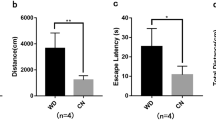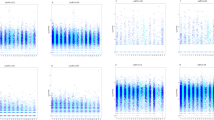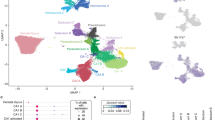Abstract
Background
Down syndrome (DS), caused by trisomy 21, is the most common human chromosomal disorder. Hippocampal abnormalities have been believed to be responsible for the DS developmental cognitive deficits. Cumulative evidences indicated that non-coding RNAs (ncRNAs) participated in brain development and function. Currently, few was known whether dysregulated ncRNAs existed in DS whether the dysregulated ncRNAs played important pathology roles in DS.
Objective
The purpose of this study was generating an overview map of the dysregulated ncRNAs in DS, including the microRNA (miRNA), long ncRNA (lncRNA) and circular RNA (circRNAs). DS mouse models are invaluable tools for further mechanism and therapy studies.
Methods
The well-studied DS mouse model Dp(16)1/Yey was used in this study as it contains the trisomy of the whole human chromosome 21 syntenic region on mouse chromosomes 16. Hippocampi were isolated from pups of seven-days-old. Libraries for miRNA, lncRNA and circRNAs were constructed separately, and the next generation sequencing method was utilized.
Results
Differentially expressed (DE) miRNAs, lncRNAs and circRNAs were reported. Relative few regulating relationship were found between the DE miRNAs and DE mRNAs. LncRNAs originated from the trisomic regions expressed in clusters, but not all of them were 1.5-fold increased expressed. Dramatic DE circular RNAs were found in the DS hippocampus. The host genes of the DE circRNAs were enriched on functions which were well-known impaired in DS, e.g. long-term-potentiation, glutamatergic synapse, and GABAergic synapse.
Conclusions
We generated the first DS developmental hippocampal ncRNA transcriptome map. This work laid foundations for further investigations on role of ncRNAs in hippocampal functions.





Similar content being viewed by others
References
Antonarakis SE (2017) Down syndrome and the complexity of genome dosage imbalance. Nat Rev Genet 18(3):147–163
Arena A, Iyer AM, Milenkovic I et al (2017) Developmental expression and dysregulation of miR-146a and miR-155 in down’s syndrome and mouse models of Down’s syndrome and Alzheimer’s disease. Curr Alzheimer Res 14:1305–1317
Chen M, Wang J, Luo Y et al (2018) Identify Down syndrome transcriptome associations using integrative analysis of microarray database and correlation-interaction network. Hum Genom 12(1):2
Dong H, Lei J, Ding L et al (2013) MicroRNA: function, detection, and bioanalysis. Chem Rev 113(8):6207–6233
Herault Y, Delabar JM, Fisher EMC et al (2017) Rodent models in down syndrome research: Impact and future opportunities. DMM Dis Models Mech 10(10):1165–1186
Jiang X, Liu C, Yu T et al (2015) Genetic dissection of the down syndrome critical region. Hum Mol Genet 24(22):6540–6551
Keck-Wherley J, Grover D, Bhattacharyya S et al (2011) Abnormal microRNA expression in Ts65Dn hippocampus and whole blood: contributions to down syndrome phenotypes. Dev Neurosci 33(5):451–467
Li B, Sun H, Zhang J (2020) LncRNA DSCAM-AS1 promotes colorectal cancer progression by acting as a molecular sponge of miR-384 to modulate AKT3 expression. Aging 12(10):9781–9792
Li L, Zhuang Y, Zhao X et al (2019) Long non-coding RNA in neuronal development and neurological disorders. Front Genet 10:1–12
Li Y, Alexandrov PN, Pogue AI et al (2012) miRNA-155 up-regulation and complement factor H (CFH) deficits in Down’s syndrome. Neuroreport 23(3):168–173
Li Z, Yu T, Morishima M et al (2007) Duplication of the entire 22.9 Mb human chromosome 21 syntenic region on mouse chromosome 16 causes cardiovascular and gastrointestinal abnormalities. Hum Mol Genet 16(11):1359–1366
Lin H, Sui W, Li W et al (2016) Integrated microRNA and protein expression analysis reveals novel microRNA regulation of targets in fetal down syndrome. Mol Med Rep 14(5):4109–4118
Lott IT, Dierssen M (2010) Cognitive deficits and associated neurological complications in individuals with Down’s syndrome. Lancet Neurol 9(6):623–633
Mercer TR, Mattick JS (2013) Structure and function of long noncoding RNAs in epigenetic regulation. Nat Struct Mole Biol 20(3):300–307
Olmos-Serrano JL, Kang HJ, Tyler WA et al (2016) Down syndrome developmental brain transcriptome reveals defective oligodendrocyte differentiation and myelination. Neuron 89:1–15
Qiu J, Liu Y, Ren Z et al (2017) Dysfunctions of mitochondria in close association with strong perturbation of long noncoding RNAs expression in down syndrome. Int J Biochem Cell Biol 92:115–120
Ragione FD, Gagliardi M, D’Esposito M et al (2014) Non-coding RNAs in chromatin disease involving neurological defects. Front Cell Neurosci 8:1–7
Reeves RH, Irving NG, Moran TH et al (1995) A mouse model for Down syndrome exhibits learning and behaviour deficits. Nat Genet 11:177–184
Robinson MD, McCarthy DJ, Smyth GK (2009) edgeR: a bioconductor package for differential expression analysis of digital gene expression data. Bioinformatics 26(1):139–140
Rossum DV, Verheijen BM, Pasterkamp RJ (2016) Circular RNAs: novel regulators of neuronal development. Front Mol Neurosci 9:1–7
Rybak-Wolf A, Stottmeister C, Glazar P et al (2015) Circular RNAs in the Mammalian brain are highly abundant, conserved, and dynamically expressed. Mol Cell 58(5):870–885
Saab BJ, Mansuy IM (2014) Neuroepigenetics of memory formation and impairment: the role of microRNAs. Neuropharmacology 80:61–69
Shi W, Liu Z, Wang H et al (2016) Integrated miRNA and mRNA expression profiling in fetal hippocampus with Down syndrome. J Biomed Sci 23(1):1–12
Sui W, Gan Q, Chang Y et al (2020) Differential expression profile study and gene function analysis of maternal foetal-derived circRNA for screening for Down’s syndrome. Exp Ther Med 19(2):1006–1016
Tripathi V, Ellis JD, Shen Z et al (2010) The nuclear-retained noncoding RNA MALAT1 regulates alternative splicing by modulating SR splicing factor phosphorylation. Mol Cell 39(6):925–938
Xu J, Zhou X, Wang J et al (2013) RhoGAPs attenuate cell proliferation by direct interaction with p53 Tetramerization domain. Cell Rep 3(5):1526–1538
Xu Y, Li W, Liu X et al (2013) Identification of dysregulated microRNAs in lymphocytes from children with down syndrome. Gene 530(2):278–286
You X, Vlatkovic I, Babic A et al (2015) Neural circular RNAs are derived from synaptic genes and regulated by development and plasticity. Nat Neurosci 18(4):603–610
Funding
This research was funded by the National Natural Science Foundation of China (81600986), Natural Science Foundation of Guangdong Province (2017A030313843) and Guangzhou Municipal Science and Technology Project (201804010079).
Author information
Authors and Affiliations
Corresponding author
Ethics declarations
Conflict of interest
The authors declare that they have no other conflict of interest.
Ethical approval
All the experimental procedures have been approved by the Animal Care and Use Committee at Guangzhou Medical University.
Additional information
Publisher's Note
Springer Nature remains neutral with regard to jurisdictional claims in published maps and institutional affiliations.
Electronic supplementary material
Below is the link to the electronic supplementary material.
Rights and permissions
About this article
Cite this article
Cai, Z., Xiao, Z., Wang, Y. et al. Comparative analysis of the down syndrome hippocampal non-coding RNA transcriptomes using a mouse model. Genes Genom 42, 1259–1265 (2020). https://doi.org/10.1007/s13258-020-00996-8
Received:
Accepted:
Published:
Issue Date:
DOI: https://doi.org/10.1007/s13258-020-00996-8




